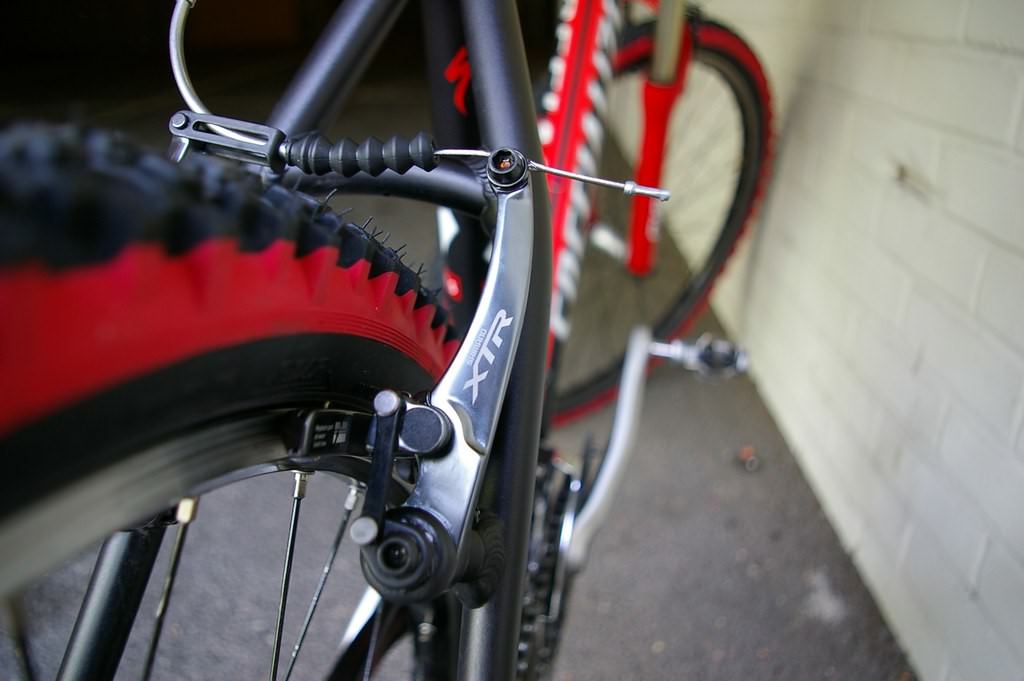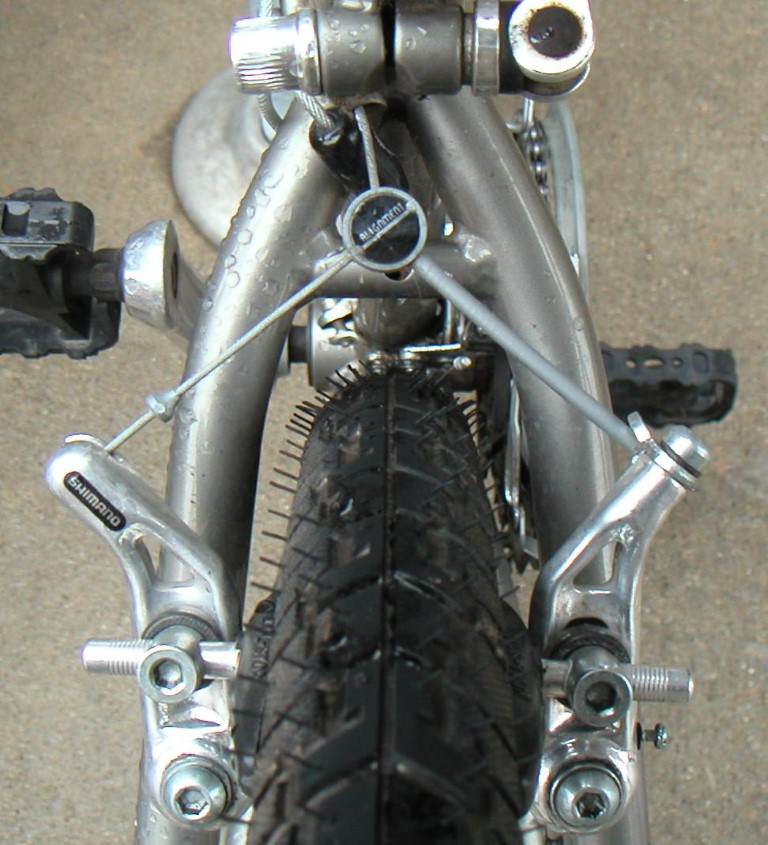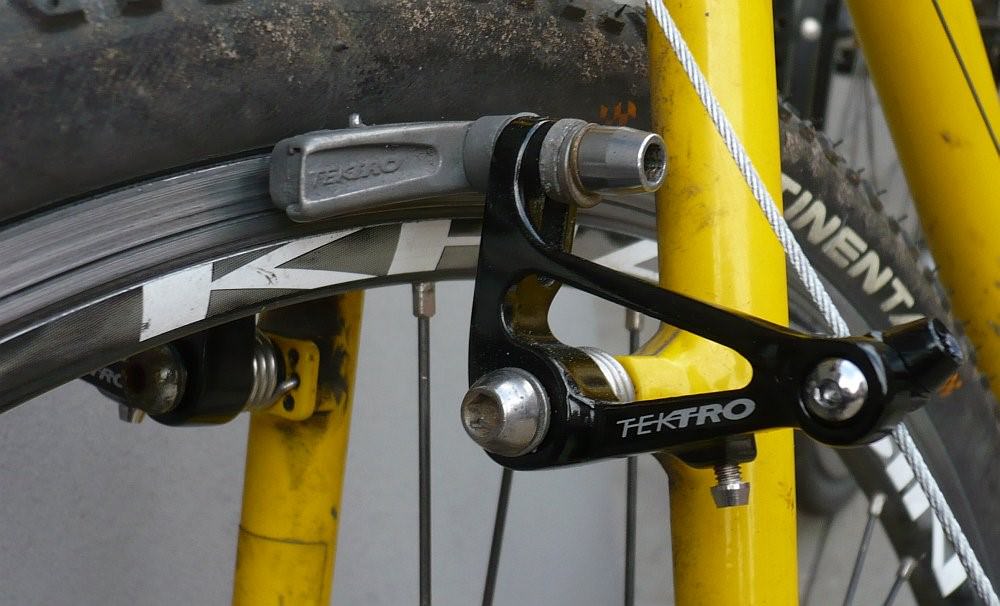Types of Brakes
There are various types of braking systems used in bicycles, with V brakes and cantilever brakes being two popular options among rim brakes. Let’s explore their characteristics and discuss their differences.
V Brakes
V brakes, also known as linear-pull brakes, consist of two arms that are mounted on the frame or fork of a bike. The brake pads are located on the arms and apply pressure on the rim when the brake lever is squeezed. V brakes are known for their easy installation, maintenance, and relatively strong stopping power. However, they can be susceptible to brake rub if not adjusted properly, and their performance may decline in wet or muddy conditions.
- Easy installation and maintenance
- Good stopping power
- Susceptible to brake rub if not adjusted correctly
- Performance may decline in wet or muddy conditions

Cantilever Brakes
Cantilever brakes are another type of rim brake system. They also consist of two arms mounted on the frame or fork, but the arms are connected to a cable that runs across the top of the tire. When the brake lever is squeezed, the arms pivot, causing the brake pads to push against the rim. Cantilever brakes offer reliable stopping power and are less prone to brake rub compared to V brakes. They also perform better in wet or muddy conditions. On the downside, they can be more difficult to adjust and maintain, and are generally not as powerful as V brakes or disc brakes.
- Reliable stopping power
- Less prone to brake rub
- Better performance in wet or muddy conditions
- Difficult to adjust and maintain
- Not as powerful as V brakes or disc brakes

Design and Mechanism
V Brakes Design
V brakes, also known as linear-pull brakes, use a mechanical cable pull system to apply braking force. They’re characterized by their parallel arms design, which is directly connected to the brake cable through a noodle-shaped guide. This design provides a mechanical advantage by increasing the force exerted onto the rims.
When the brake lever is pulled, the cable tightens, causing the arms to move inward and press the brake pads against the wheel’s rim. The pulling angle of the cable helps in evenly distributing force, resulting in efficient and consistent braking performance. V brakes work well on a variety of bicycles, particularly mountain bikes and hybrid bikes.
Cantilever Brakes Design
Cantilever brakes, on the other hand, have a different design from V brakes. They consist of two separate brake arms, with each arm mounted to a separate pivot point on the bicycle frame or fork. The brake arms are connected by a transverse cable that’s pulled upward by the main brake cable when the lever is squeezed.
The cantilever braking system operates on a mechanical advantage principle, where the force exerted by the rider is multiplied by the leverage provided by the brake arms. When the brake lever is pulled, the transverse cable pushes the brake arms outward, pressing the brake pads against the rim. This design allows the brake pads to clear mud and debris, making them a popular choice for cyclocross and touring bikes.
Both V brakes and cantilever brakes are mechanical systems that rely on cables, wires, and brake pads to provide braking power. Each type has its own unique advantages and disadvantages related to the design, mechanical cable pull, mechanical advantage, pulling angle, and how the brake pads interact with the bike’s rims.
Braking Performance
The main factors that determine the performance of a braking system are its stopping power and modulation. Comparing V brakes and cantilever brakes in these aspects will help determine which system offers better braking performance.
Stopping Power
Stopping power refers to the ability of a brake system to bring a bike to a halt as quickly and efficiently as possible. V brakes, also known as linear-pull brakes, are known for their superior stopping power when compared to cantilever brakes. This is because the design of V brakes allows for a more direct application of force on the rim, leading to better braking power.
In wet or rainy conditions, V brakes maintain their edge over cantilever brakes. They tend to offer a more consistent performance and faster stops, as their design helps to shed water from the rim more effectively.
Modulation
Modulation is the ability of a brake system to provide smooth and controlled braking, without locking the wheels. When discussing modulation, cantilever brakes have a slight advantage over V brakes. Their design allows for more subtle control of the braking force, making it easier for riders to apply the exact amount of pressure needed for a comfortable and controlled stop.
However, it’s worth noting that the difference in modulation between the two systems might not be dramatic, and individual preferences and riding styles can impact a rider’s experience with each type of brake. Ultimately, the choice between V brakes and cantilever brakes will depend on the specific needs and preferences of the rider.
Compatibility and Usage
When it comes to selecting the right type of brakes for one’s bike, compatibility and usage play a major role. Different types of bikes cater to particular riding styles and require specific brake systems. In this section, we will explore how V-brakes and cantilever brakes fare in various types of bikes, including road bikes, mountain bikes, touring bikes, and cyclocross bikes.
Road Bikes
Road bikes are typically built for speed and performance. Cantilever brakes have long been the traditional choice for road bikes, offering adequate stopping power while maintaining a lightweight design. However, today’s road bikes might require more powerful braking systems for effective stopping in city-type settings. V-brakes offer a more modern alternative, providing increased braking power while still maintaining a sleek appearance.
Mountain Bikes
Mountain bikes need reliable brakes that work consistently in varying terrain and weather conditions. When it comes to off-road cycling and competitive riding, the choice between V-brakes and cantilever brakes is clearer. V-brakes have become the standard for most mountain bikes, as they offer superior stopping power, modulation, and ease of maintenance, compared to cantilever brakes.
Touring Bikes
Touring bikes are designed for long-distance cycling, often carrying heavy loads. When it comes to braking systems, both V-brakes and cantilever brakes can fit the bill for touring bikes. However, V-brakes offer better stopping power and easier maintenance, making them the more preferred choice among touring cyclists. Cantilever brakes can still be a viable option, as they allow for better clearance for mudguards and wider tires.
Cyclocross Bikes
Cyclocross bikes are designed for mixed terrain racing, combining elements of road and off-road cycling. Cantilever brakes have traditionally been the go-to choice for cyclocross bikes, offering adequate stopping power and wider clearance for muddy conditions. However, V-brakes have gained popularity in recent years, offering better braking performance while still maintaining sufficient clearance for cyclocross tires.
Installation and Adjustment
Installing V Brakes
To install V brakes, first gather the necessary tools, such as a wrench, hex keys, and screwdrivers. Start by attaching the brake arms to the frame’s brake mounts, ensuring they’re securely fastened.
Next, insert the brake cable through the brake lever’s barrel adjuster and secure it to the brake arm’s cable clamp. Ensure proper cable tension, as it’s crucial for effective braking.
Installing Cantilever Brakes
For cantilever brakes, you’ll also need a wrench, hex keys, and screwdrivers. Attach the brake arms to the frame’s brake bosses, then connect the brake cable to the brake levers.
Install the straddle cable between the two brake arms, ensuring that it’s both centered and secure. Finally, attach the brake pads and adjust their position, so they’re parallel to the rim as they make contact.
Adjusting V Brakes
Adjusting V brakes starts with addressing pad placement. Ensure the pads are parallel to the rim’s braking surface and adjust them if needed. Next, verify that the brake arms move evenly and smoothly by lightly squeezing the brake levers.
If the brake arms don’t move in sync, use the spring adjustment screws located at the base of the V brake arms to adjust the tension. Turn the screw either clockwise or counterclockwise to increase or decrease tension until the brake arms move uniformly.
Adjusting Cantilever Brakes
You’ll want to ensure the pads on cantilever brakes are also parallel to the rim’s braking surface, as well as the straddle cable is installed correctly. If needed, adjust the pads using the pad adjustment bolts.
Should the brake arms not move evenly, use the spring adjustment screws found on cantilever brake bosses to address the issue. Similar to V brakes, turn the screw either clockwise or counterclockwise to fine-tune the spring tension and balance the brake arms.
Maintenance and Troubleshooting
V Brakes Maintenance
For V brakes, maintenance is generally straightforward. Regularly inspect the brake pads for wear and replace them when needed. To maintain optimal braking performance, it’s important to keep the rims clean and free of debris.
- Brake pads: Check for even wear and proper alignment with the rim. Replace worn or damaged pads.
- Rims: Clean them with a cloth and mild soap to remove dirt and grime. Inspect for cracks or dents, and replace when necessary.
- Brake levers: Ensure they’re tightly secured to the handlebars and functioning smoothly.
Cantilever Brakes Maintenance
Similar to V brakes, cantilever brakes also require regular inspections and adjustments. Pay attention to the brake pads, rims, and brake levers for optimal performance.
- Brake pads: Check for even wear and proper contact with the rim. Replace if damaged or worn out.
- Rims: Clean with a cloth and mild soap to remove dirt and grime. Inspect for damage or wear, and replace when necessary.
- Brake levers: Ensure they’re securely attached to the handlebars and functioning properly.
- Tire clearance: Make sure cantilever arms have adequate tire clearance to prevent rubbing.
Common Issues
| Issue | V Brakes | Cantilever Brakes |
|---|---|---|
| Brake pad wear | Replace brake pads when worn or damaged | Replace brake pads when worn or damaged |
| Brake lever problems | Check for proper installation and adjust if needed | Check for proper installation and adjust if needed |
| Rim damage | Inspect and replace rims when necessary | Inspect and replace rims when necessary |
| Tire clearance | Usually not a concern | Ensure adequate clearance between tire and cantilever arms |
Pros and Cons
Advantages of V Brakes
When it comes to strength, V brakes have a clear advantage. They offer increased braking power compared to cantilever brakes, which means they’re more effective at stopping your bike quickly. This feature can be particularly useful in emergency situations when you need to slow down fast.
Another benefit of V brakes is their linear design, which contributes to better modulation. Modulation refers to the amount of control you have over your brakes, and better modulation allows you to fine-tune your braking force. This can help prevent locking out your wheels, which could cause you to skid or lose control.
Finally, V brakes typically have a simple noodle holder that’s easy to maintain and adjust compared to the anchor bolt system found in cantilever brakes. This can make V brakes more user-friendly and save time when making adjustments.
Advantages of Cantilever Brakes
Cantilever brakes excel in muddy conditions. Their wide spacing allows for better mud clearance, which means they’re less likely to become clogged or compromised in performance when you’re riding through gritty, dirty terrain.
Another advantage of cantilever brakes is their compatibility with a wider range of bike frames and forks. They’re adaptable to various configurations, which can be particularly useful for those looking to upgrade their bike’s braking system without making significant changes to the frame or fork.
Disadvantages of V Brakes
While V brakes have their strengths, they also come with a few drawbacks. One notable disadvantage is their lack of compatibility with some types of bike frames and forks. This can make it challenging to install V brakes on certain bikes, especially older models or those with unique frame designs.
Additionally, as powerful as they are, V brakes may be prone to locking out your wheels in certain situations, particularly for inexperienced riders. This can make them less forgiving than cantilever brakes when it comes to fine-tuning your braking.
Disadvantages of Cantilever Brakes
On the other hand, cantilever brakes have their own weaknesses. One of the primary disadvantages is their lower overall braking strength compared to V brakes. This means they require more effort to achieve the same stopping power, which can become tiresome on long rides or in challenging conditions.
Another issue with cantilever brakes is their anchor bolt system, which can be more challenging to adjust and maintain than V brakes’ noodle holder. This additional complexity can make cantilever brakes less user-friendly for those without much experience working on bikes.
Alternative Brake Systems
While V-brakes and cantilever brakes are popular choices for cyclists, it’s important to consider alternative brake systems as well. Within this section, we’ll explore two other common bicycle brake types: disc brakes and caliper brakes.
Disc Brakes
Disc brakes are becoming increasingly popular for their effective stopping power and ability to handle challenging conditions. They work by utilizing a metal disc, also known as a rotor, which is attached to the wheel hub. When the brake lever is engaged, brake pads are pressed against the rotor, slowing the wheel down.
Disc brakes can be either hydraulic or mechanical. Hydraulic disc brakes utilize fluid pressure to engage the brake pads, while mechanical disc brakes rely on a cable and pulley system. Both versions provide consistent and efficient stopping power regardless of the weather or riding conditions. There are a few advantages and disadvantages to consider:
- Advantages: Excellent stopping power, consistent performance in various conditions, less rim wear, and lower maintenance.
- Disadvantages: Potential added weight, possible complexity in maintenance, and costlier compared to rim brakes.
Caliper Brakes
Caliper brakes are another common brake system typically found on road bikes. They consist of a single brake unit that clamps onto the wheel’s rim using a cable and lever. Caliper brakes are lightweight, easy to maintain, and have a sleek appearance.
Caliper brakes can be divided into two categories: side-pull and center-pull. Side-pull caliper brakes have a single pivot point on the side and are easier to set up, while center-pull calipers have a double pivot system, offering balanced braking but requiring more skill to adjust. The pros and cons of caliper brakes include:
- Advantages: Lightweight, simple design, easy to maintain, and aesthetically pleasing.
- Disadvantages: Limited stopping power compared to disc brakes, adversely affected by wet weather, and can cause rim wear over time.
In summary, each brake system offers unique characteristics that cater to varying cycling needs. Disc brakes provide powerful and consistent braking in challenging circumstances, while caliper brakes are known for their lightweight design and easy maintenance. It’s essential to weigh the pros and cons of each option to determine the best brake system for your specific cycling requirements.
